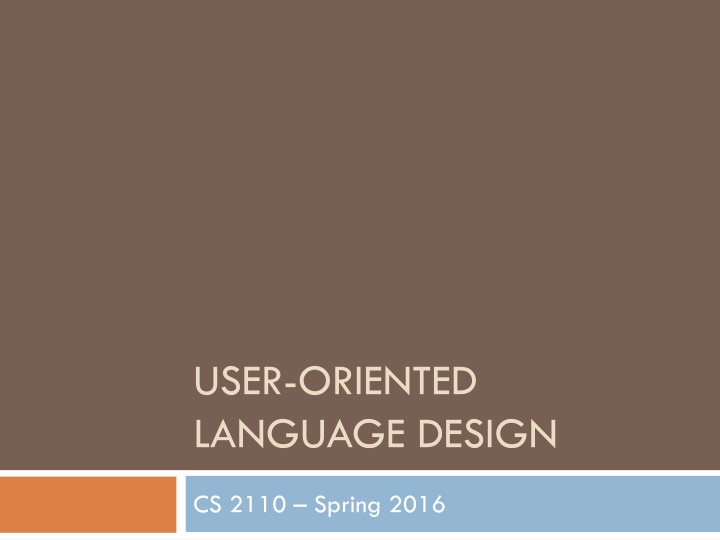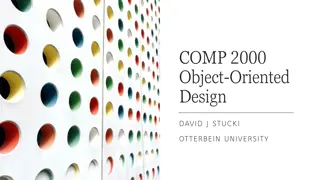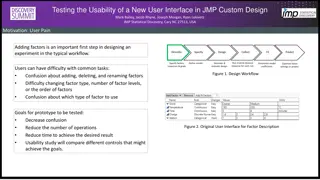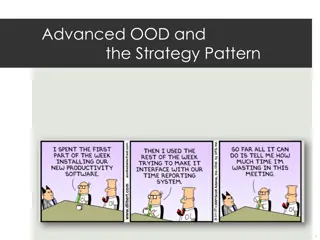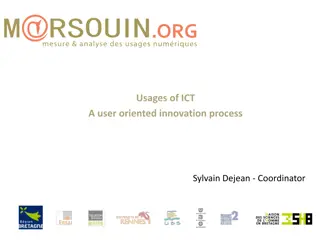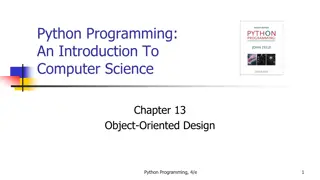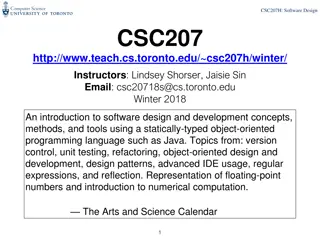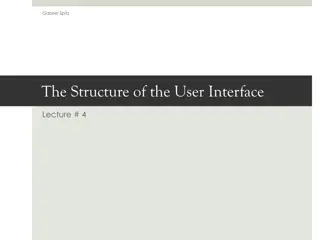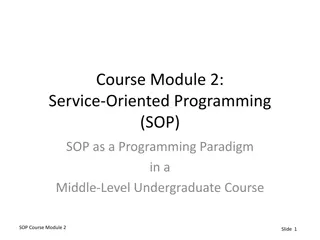USER-ORIENTED LANGUAGE DESIGN
Learn about user-oriented language design in the CS 2110 course offered in the Spring of 2016. Explore topics such as decidability, wildcards, subtyping, efficiency, restrictions, and more through practical examples and theoretical concepts. Gain insights into industry collaborations and the analysis of millions of lines of code, emphasizing the importance of understanding materials, shapes, and the human aspect of programming.
Download Presentation

Please find below an Image/Link to download the presentation.
The content on the website is provided AS IS for your information and personal use only. It may not be sold, licensed, or shared on other websites without obtaining consent from the author.If you encounter any issues during the download, it is possible that the publisher has removed the file from their server.
You are allowed to download the files provided on this website for personal or commercial use, subject to the condition that they are used lawfully. All files are the property of their respective owners.
The content on the website is provided AS IS for your information and personal use only. It may not be sold, licensed, or shared on other websites without obtaining consent from the author.
E N D
Presentation Transcript
USER-ORIENTED LANGUAGE DESIGN CS 2110 Spring 2016
Wildcards public Variable { boolean value; /** Add this to the list corresponding to value */ public void addTo( List<? super Variable> trues, List<? super Variable> falses) { (value ? trues : falses).add(this); } }
Subtyping Contrived class C P extends D D ? super C L P {} C X <: D ? super C X Inheritance D D ? super C L X <: D ? super C X Instantiation C X <: D ? super C L X Inheritance D D ? super C L X <: D ? super C L X Instantiation C L X <: D ? super C L X
Restrictions Contrived class C P extends D D ? super C L P {} Inheritance Restriction No use of ? super in the inheritance hierarchy Contrived P extends List List ? super C L P Parameter Restriction When constraining type parameters, ? super may only be used at covariant locations
9.2 Million Lines of Code Analyzed Survey Wildcards in Inheritance Wildcards in Constraints 100000 100000 10000 10000 1000 1000 100 0.1 0 Only 10 1 Unconstrained Wildcards 3.7% No Wildcards 20.9% No Type Arguments No Wildcards Only Unconstrained Wildcards Uses ? extends 1.5% Only Unconstrained No Type Arguments 72.0% Uses ? extends Uses ? super 1.8% Uses ? super # of Superclass Declarations All at covariant locations
Industry Collaborations at on Gavin King at on Andrey Breslav
Materials and Shapes Material List, Integer, Property, Comparator Shape Comparable, Summable, Cloneable No class/interface is both a material and a shape 13.5 Million Lines of Code Analyzed
Library Designer Want to provide a separate function Inputs: middle, elems, smaller, bigger Requirements: Place all values in elems less than middle into smaller Place all other values in elems into bigger Goals Implement separate Provide maximally flexible type signature
Library User Goal Place nonnegative values in ints into positives Context ignore throws away all elements added to it Implementation separate(0, ints, ignore, positives);
User Types ints : Iterable<Integer> You can get things from iterables positives : Collection<Integer> You can add things to collections ignore : Collection<Object> You can add anything to it Integer implements Comparable<Number> integers can be compared with any number
Library Implementation void separate(middle, foreach (elem in elems) (elem < middle ? smaller : bigger) } elems, smaller, bigger) { .add(elem);
Library Type <T extends Comparable<T>> void separate(T middle, Iterable<T> elems, Collection<T> smaller, Collection<T> bigger) { foreach (elem in elems) (elem < middle ? smaller : bigger) } .add(elem);
Insufficient Flexibility Actuals Integer 0 ints ignore positives Formals <T extends Comparable<T>> void separate(T middle, Iterable<T> elems, Collection<T> smaller, Collection<T> bigger)
Wildcards <T extends Comparable<? super T>> void separate(T middle, Iterable<? extends T> elems, Collection<? super T> smaller, Collection<? super T> bigger) { foreach (elem in elems) (elem < middle ? smaller : bigger) } .add(elem);
Excessive Annotations <T> void flatten( Iterable<? extends Iterable<? extends T>> colls, Collection<? super T> into) { for (Iterable<? extends T> coll : colls) for (T elem : coll) into.add(elem); }
Declaration-Site Variance <T extends Comparable<T>> void separate(T middle, Iterable<T> elems, Collection<T> smaller, Collection<T> bigger) { foreach (elem in elems) (elem < middle ? smaller : bigger) } .add(elem);
Insufficient Flexibility Actuals Integer 0 ints ignore positives Formals <T extends Comparable<T>> void separate(T middle, Iterable<T> elems, Collection<T> smaller, Collection<T> bigger)
Declaration-Site Variance Retry <T extends Comparable<T>, U super T, V super T> void separate(T middle, Iterable<T> elems, Collection<U> smaller, Collection<V> bigger) { foreach (elem in elems) (elem < middle ? smaller : bigger) } .add(elem);
Mixed-Site Variance <T extends Comparable<T>> void separate(T middle, Iterable<T> elems, Collection<in T> smaller, Collection<in T> bigger) { foreach (elem in elems) (elem < middle ? smaller : bigger) } .add(elem);
Use+Declaration-Site The two address orthogonal roles declaration-site for class/interface designers use-site for class/interface users How do the two interact? given interface Iterator<out T> { } what does Iterator<in Number> mean?
Expectations vs. Designs Default Mixed Layer Scala Java Join Has declaration-site variance C<?> <: C<out ?> C<out ?> <: C<out ? > implies ? <: ? instance of C<out > is instance of C< > for some <: instance of C<out > allocated as C< > for some <: C<in out > is expressible C<in out > is valid implies C< > is valid Out<in > is valid implicit constraints used in subtyping
Principal Type The principal type of an expression a type for that expression that is better than all other types for that expression Hello has principal type String Hello also has type Object, CharSequence, String is a subtype of all those types A language has principal types if every possible expression has a principal type
Java assertEquals(5, Integer.valueOf(5)) ambiguous! Is it two ints or two Integers? But the expression 5 is also an Integer And Integer.valueOf(5) is also an int Neither expression has a principal type
Ambiguous Semantics P List P singleton(P elem) {return null;} Q extends Comparable ? Q foo(List ? super Q list) {return null;} javac Comparable String typeName(Comparable ? c) {return Comparable ;} String typeName(String s) {return String ;} String typeName(Integer i) {return Integer ;} String typeName(Calendar c) {return Calendar ;} String Smith & Cartwright Integer P Object String ambiguous(boolean b) { return typeName(foo(singleton(b ? Blah : 1))); } Socrates Calendar Q Calendar
Use-Site Inferability Check T List T singletonList(T) {...} var objs = singletonList( Hello ); objs.add(5); fails to type check objs is inferred to be an List String needs to be an List Object
Declaration-Site Inferability T List T singletonList(T) T is not inferable because Array is invariant singletonList( Hello ) could have type List String or List Object no principal type T Iterable ? extends T singletonIterable(T) T is inferable because ? extends is covariant singletonIterable( Hello ) has type Iterable ? extends String which is subtype of Iterable ? extends Object
Goal Mix static and dynamic type systems e.g. Java with JavaScript Requirements no implicit insertions of wrappers dynamic code is just static code minus types stripping types preserves or improves semantics static code can assume type annotations are true
C#s dynamic Type bool Equal(object left, object right) { return left == right; } Equal(0, 0) returns false
C#s dynamic Type interface Getter T { T get(); } class Five : Getter int , Getter string { int Getter int .get() { return 5; } double Getter string .get() { return 5.0; } } void Print(Getter int getter) { Console.WriteLine(getter.get()); } Crashes if changed to dynamic!
C#s dynamic Type List T Snoc T (IEnumerable T start, T end) { var elems = ToList(start); elems.add(end); return elems; } Crashes if made dynamic! Snoc(Singleton( Hello ), 5) works
Prerequisite Language Properties Static Behavioral Subtyping Using a more precise type for a subexpression improves the typability of the whole expression Decidability Typing must be reliably doable at run time Principality Every execution has a most precise typing
